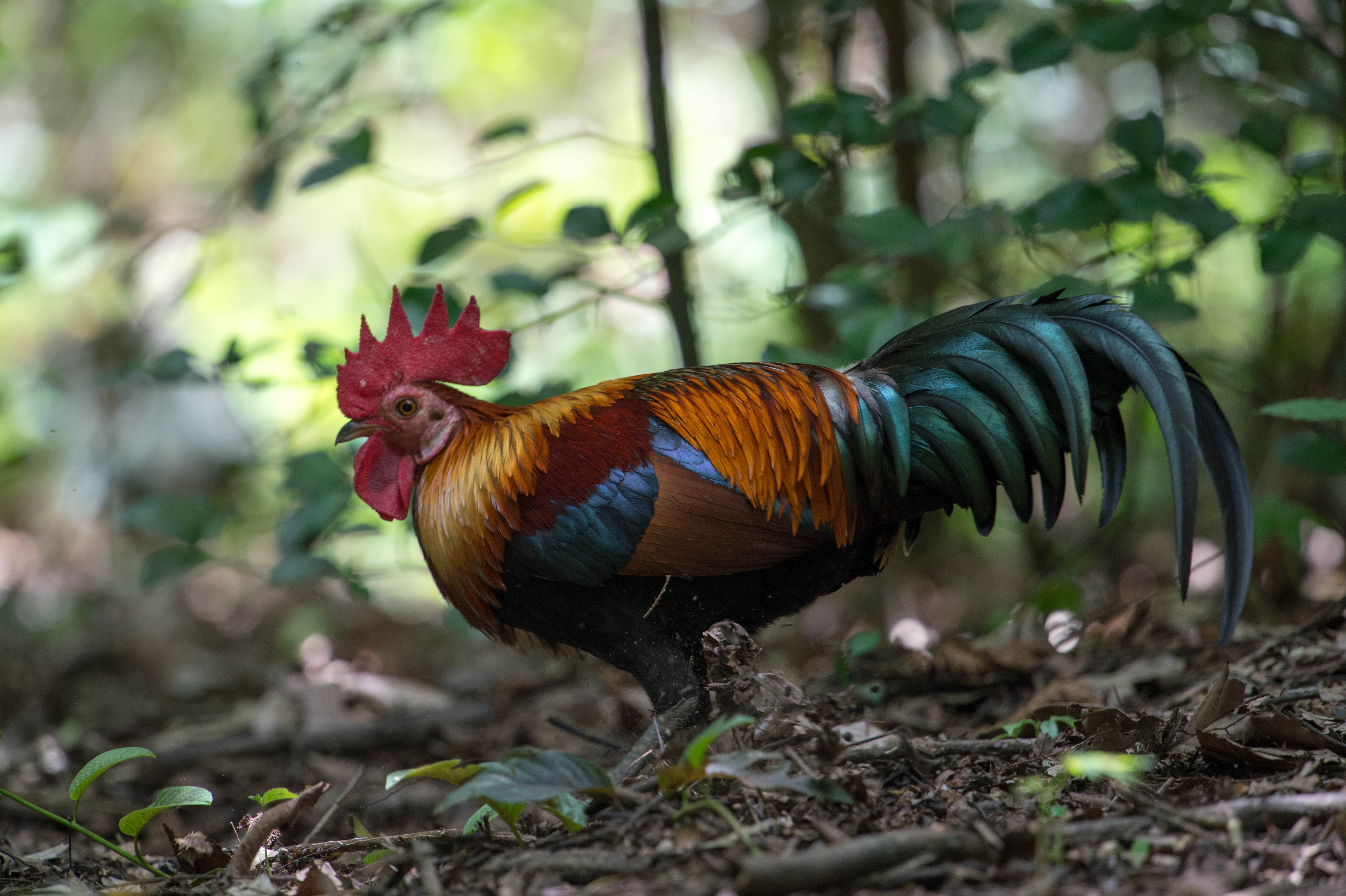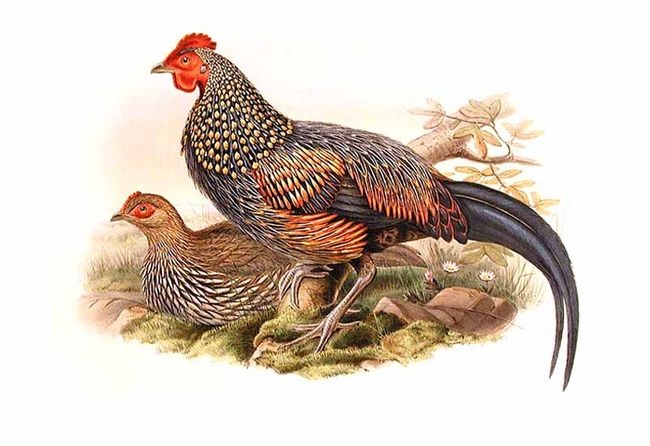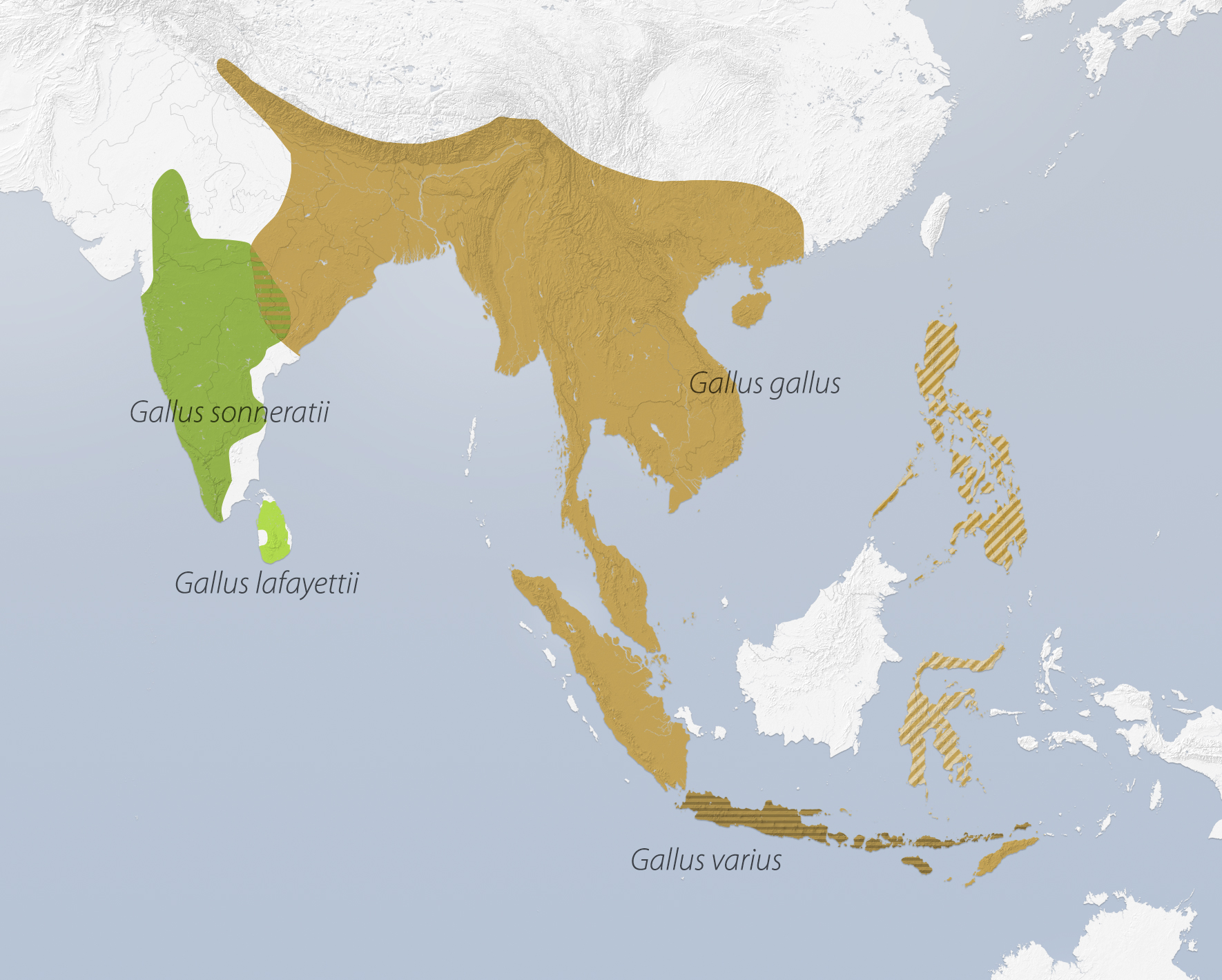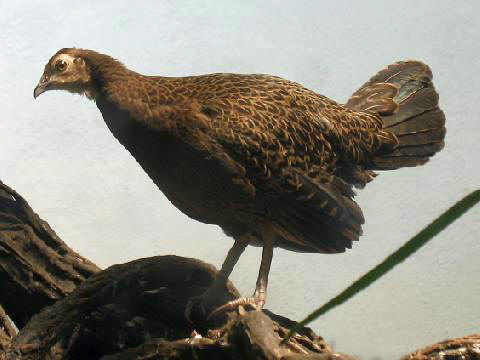|
Junglefowl
Junglefowl are the only four living species of bird from the genus ''Gallus'' in the bird order Galliformes, and occur in parts of South and Southeast Asia. They diverged from their common ancestor about 4–6 million years ago. Although originating in Asia, remains of junglefowl bones have also been found in regions of Chile, which date back to 1321–1407 CE, providing evidence of possible Polynesian migration through the Pacific Ocean. These are large birds, with colourful plumage in males, but are nevertheless difficult to see in the dense vegetation they inhabit. As with many birds in the pheasant family, the male takes no part in the incubation of the egg or rearing of the precocial young. These duties are performed by the drab and well-camouflaged female. Females and males do not form pair bonds; instead, the species has a polygynandrous mating system in which each female will usually mate with several males. Aggressive social hierarchies exist among both females a ... [...More Info...] [...Related Items...] OR: [Wikipedia] [Google] [Baidu] |
Red Junglefowl
The red junglefowl (''Gallus gallus'') is a tropical bird in the family Phasianidae. It ranges across much of Southeast Asia and parts of South Asia. It was formerly known as the Bankiva or Bankiva Fowl. It is the species that gave rise to the chicken (''Gallus gallus domesticus''); the grey junglefowl, Sri Lankan junglefowl and green junglefowl have also contributed genetic material to the gene pool of the chicken. Evidence from the molecular level derived from whole-genome sequencing revealed that the chicken was domesticated from red junglefowl about 8,000 years ago, with this domestication event involving multiple maternal origins. Since then, their domestic form has spread around the world where they are kept by humans for their meat, eggs, and companionship. Taxonomy and systematics Numerous subspecies of ''Gallus gallus'' exist, including: * ''G. g. gallus'' – from India, Bangladesh, Southeast Asia * ''G. g. bankiva'' – from Java and Sumatra * ''G. g. jabouill ... [...More Info...] [...Related Items...] OR: [Wikipedia] [Google] [Baidu] |
Gallus Gallus
The red junglefowl (''Gallus gallus'') is a tropical bird in the family Phasianidae. It ranges across much of Southeast Asia and parts of South Asia. It was formerly known as the Bankiva or Bankiva Fowl. It is the species that gave rise to the chicken (''Gallus gallus domesticus''); the grey junglefowl, Sri Lankan junglefowl and green junglefowl have also contributed genetic material to the gene pool of the chicken. Evidence from the molecular level derived from whole-genome sequencing revealed that the chicken was domesticated from red junglefowl about 8,000 years ago, with this domestication event involving multiple maternal origins. Since then, their domestic form has spread around the world where they are kept by humans for their meat, eggs, and companionship. Taxonomy and systematics Numerous subspecies of ''Gallus gallus'' exist, including: * ''G. g. gallus'' – from India, Bangladesh, Southeast Asia * ''G. g. bankiva'' – from Java and Sumatra * ''G. g. jabouille ... [...More Info...] [...Related Items...] OR: [Wikipedia] [Google] [Baidu] |
Red Junglefowl
The red junglefowl (''Gallus gallus'') is a tropical bird in the family Phasianidae. It ranges across much of Southeast Asia and parts of South Asia. It was formerly known as the Bankiva or Bankiva Fowl. It is the species that gave rise to the chicken (''Gallus gallus domesticus''); the grey junglefowl, Sri Lankan junglefowl and green junglefowl have also contributed genetic material to the gene pool of the chicken. Evidence from the molecular level derived from whole-genome sequencing revealed that the chicken was domesticated from red junglefowl about 8,000 years ago, with this domestication event involving multiple maternal origins. Since then, their domestic form has spread around the world where they are kept by humans for their meat, eggs, and companionship. Taxonomy and systematics Numerous subspecies of ''Gallus gallus'' exist, including: * ''G. g. gallus'' – from India, Bangladesh, Southeast Asia * ''G. g. bankiva'' – from Java and Sumatra * ''G. g. jabouill ... [...More Info...] [...Related Items...] OR: [Wikipedia] [Google] [Baidu] |
Sri Lankan Junglefowl
The Sri Lankan junglefowl (''Gallus lafayettii'' sometimes spelled ''Gallus lafayetii''), also known as the Ceylon junglefowl or Lafayette's junglefowl, is a member of the Galliformes bird order which is endemic to Sri Lanka, where it is the national bird. It is closely related to the red junglefowl (''G. gallus''), the wild junglefowl from which the chicken was domesticated. However, a whole-genome molecular study rather show that Sri Lankan junglefowl and grey junglefowl are genetically sister species than with the red junglefowl. Sri Lankan junglefowl and red junglefowl diverged about 2.8 million years ago, whereas time of divergence between the Sri Lankan junglefowl and grey junglefowl was 1.8 million years ago. Evidence of introgressive hybridization from Sri Lanka junglefowl has also been established in domestic chicken. The specific name of the Sri Lankan junglefowl commemorates the French aristocrat Gilbert du Motier, marquis de La Fayette. Description As with other j ... [...More Info...] [...Related Items...] OR: [Wikipedia] [Google] [Baidu] |
Grey Junglefowl
The gray junglefowl (''Gallus sonneratii''), also known as Sonnerat's junglefowl, is one of the wild ancestors of the Chicken, domestic chicken together with the red junglefowl and other junglefowls. The species epithet commemorates the French explorer Pierre Sonnerat. Local names include ''Komri'' in Rajasthan, ''Geera kur'' or ''Parda komri'' in Gondi language, Gondi, ''Jangli Murghi'' in Hindi, ''Raan kombdi'' in Marathi language, Marathi, ''Kattu Kozhi'' in Tamil language, Tamil and Malayalam, ''Kaadu koli'' in Kannada and ''Tella adavi kodi'' in Telugu language, Telugu. Description The male has a black cape with ochre spots and the body plumage on a grey ground colour is finely patterned. The elongated neck feathers are dark and end in a small, hard, yellowish plate; this peculiar structure making them popular for making high-grade Artificial fly, artificial flies. The male has red wattles and combs but not as strongly developed as in the red junglefowl. Legs of males a ... [...More Info...] [...Related Items...] OR: [Wikipedia] [Google] [Baidu] |
Grey Junglefowl
The gray junglefowl (''Gallus sonneratii''), also known as Sonnerat's junglefowl, is one of the wild ancestors of the Chicken, domestic chicken together with the red junglefowl and other junglefowls. The species epithet commemorates the French explorer Pierre Sonnerat. Local names include ''Komri'' in Rajasthan, ''Geera kur'' or ''Parda komri'' in Gondi language, Gondi, ''Jangli Murghi'' in Hindi, ''Raan kombdi'' in Marathi language, Marathi, ''Kattu Kozhi'' in Tamil language, Tamil and Malayalam, ''Kaadu koli'' in Kannada and ''Tella adavi kodi'' in Telugu language, Telugu. Description The male has a black cape with ochre spots and the body plumage on a grey ground colour is finely patterned. The elongated neck feathers are dark and end in a small, hard, yellowish plate; this peculiar structure making them popular for making high-grade Artificial fly, artificial flies. The male has red wattles and combs but not as strongly developed as in the red junglefowl. Legs of males a ... [...More Info...] [...Related Items...] OR: [Wikipedia] [Google] [Baidu] |
Green Junglefowl
The green junglefowl (''Gallus varius''), also known as Javan junglefowl, forktail or green Javanese junglefowl, is the most distantly related and the first to diverge at least 4 million years ago among the four species of the junglefowl. Hybridization with domestic chicken has also been reported. Green junglefowl is a medium-sized (up to 75 cm long) bird in the pheasant Family (biology), family Phasianidae. Description The colouration of the green junglefowl is sexually dimorphic. The male's plumage is dark and blackish at a distance. A closer view reveals an iridescent mantle of gleaming scales reminiscent in colour and pattern to those seen in the ocellated turkey and green peafowl. Each scale is vivid blue at its base and moves through various shades of gold and bronzed green. Specialized plumes framing the throat of the male green junglefowl are highly light-reflective and appear violet at the proximal and sky blue at the distal edges. The lesser coverts of the wi ... [...More Info...] [...Related Items...] OR: [Wikipedia] [Google] [Baidu] |
Green Junglefowl
The green junglefowl (''Gallus varius''), also known as Javan junglefowl, forktail or green Javanese junglefowl, is the most distantly related and the first to diverge at least 4 million years ago among the four species of the junglefowl. Hybridization with domestic chicken has also been reported. Green junglefowl is a medium-sized (up to 75 cm long) bird in the pheasant Family (biology), family Phasianidae. Description The colouration of the green junglefowl is sexually dimorphic. The male's plumage is dark and blackish at a distance. A closer view reveals an iridescent mantle of gleaming scales reminiscent in colour and pattern to those seen in the ocellated turkey and green peafowl. Each scale is vivid blue at its base and moves through various shades of gold and bronzed green. Specialized plumes framing the throat of the male green junglefowl are highly light-reflective and appear violet at the proximal and sky blue at the distal edges. The lesser coverts of the wi ... [...More Info...] [...Related Items...] OR: [Wikipedia] [Google] [Baidu] |
Chicken
The chicken (''Gallus gallus domesticus'') is a domesticated junglefowl species, with attributes of wild species such as the grey and the Ceylon junglefowl that are originally from Southeastern Asia. Rooster or cock is a term for an adult male bird, and a younger male may be called a cockerel. A male that has been castrated is a capon. An adult female bird is called a hen and a sexually immature female is called a pullet. Humans now keep chickens primarily as a source of food (consuming both their meat and eggs) and as pets. Traditionally they were also bred for cockfighting, which is still practiced in some places. Chickens are one of the most common and widespread domestic animals, with a total population of 23.7 billion , up from more than 19 billion in 2011. There are more chickens in the world than any other bird. There are numerous cultural references to chickens – in myth, folklore and religion, and in language and literature. Genetic studies have pointed to mult ... [...More Info...] [...Related Items...] OR: [Wikipedia] [Google] [Baidu] |
Phasianidae
The Phasianidae are a family (biology), family of heavy, ground-living birds, which includes pheasants, partridges, junglefowl, chickens, Turkey bird, turkeys, Old World quail, and peafowl. The family includes many of the most popular Game (hunting), gamebirds. The family is a large one and includes 185 species divided into 54 genera. It was formerly broken up into two subfamily (biology), subfamilies, the Phasianinae and the Perdicinae. However, this treatment is now known to be paraphyly, paraphyletic and polyphyly, polyphyletic, respectively, and more recent evidence supports breaking it up into two subfamilies: Rollulinae and Phasianinae, with the latter containing multiple Tribe (biology), tribes within two Clade, clades. The New World quail (Odontophoridae) and guineafowl (Numididae) were formerly sometimes included in this family, but are now typically placed in families of their own; conversely, grouse and turkey (bird), turkeys, formerly often treated as distinct families ... [...More Info...] [...Related Items...] OR: [Wikipedia] [Google] [Baidu] |
Galliformes
Galliformes is an order of heavy-bodied ground-feeding birds that includes turkeys, chickens, quail, and other landfowl. Gallinaceous birds, as they are called, are important in their ecosystems as seed dispersers and predators, and are often reared by humans for their meat and eggs, or hunted as game birds. The order contains about 290 species, inhabiting every continent except Antarctica, and divided into five families: Phasianidae (including chicken, quail, partridges, pheasants, turkeys, peafowl (peacocks) and grouse), Odontophoridae (New World quail), Numididae (guinea fowl), Cracidae (including chachalacas and curassows), and Megapodiidae (incubator birds like malleefowl and brush-turkeys). They adapt to most environments except for innermost deserts and perpetual ice. Many gallinaceous species are skilled runners and escape predators by running rather than flying. Males of most species are more colorful than the females, with often elaborate courtship behaviors t ... [...More Info...] [...Related Items...] OR: [Wikipedia] [Google] [Baidu] |
Common Pheasant
The common pheasant (''Phasianus colchicus'') is a bird in the pheasant family (biology), family (Phasianidae). The genus name comes from Latin ''phasianus'', "pheasant". The species name ''colchicus'' is Latin for "of Colchis" (modern day Georgia (country), Georgia), a country on the Black Sea where pheasants became known to Europeans. Although ''Phasianus'' was previously thought to be closely related to the genus ''Gallus'', the genus of junglefowl and domesticated chickens, recent studies show that they are in different subfamilies, having diverged over 20 million years ago. It is native to Asia and parts of Europe like the northern foothills of the Caucasus and the Balkans. It has been widely introduced elsewhere as a game bird. In parts of its range, namely in places where none of its relatives occur such as in Europe, where it is naturalised, it is simply known as the "pheasant". Ring-necked pheasant is both the name used for the species as a whole in North America and al ... [...More Info...] [...Related Items...] OR: [Wikipedia] [Google] [Baidu] |
-9858%2C_crop.jpg)










.jpg)